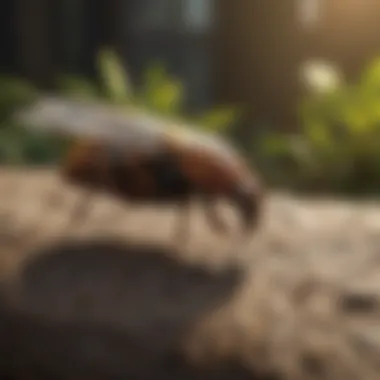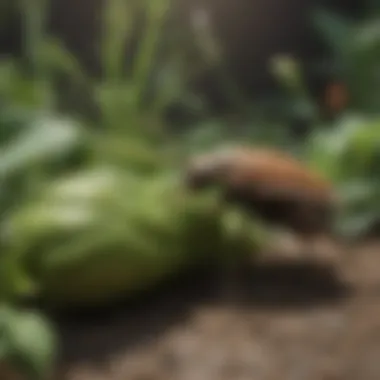Effective Natural Methods to Eliminate Squash Bugs in Your Garden


Preventive Pest Control Strategies
When it comes to safeguarding your home against pesky invaders like squash bugs, implementing preventive pest control strategies is paramount. One of the key areas to focus on is ensuring your house exterior is well-protected. This involves sealing any cracks or crevices that could serve as entry points for bugs. Additionally, clearing debris around your home and creating barriers to prevent pests from infiltrating are essential steps.
Yard maintenance is another crucial aspect of pest control. Establishing and maintaining essential yard care routines, such as regular mowing and trimming, can help deter pests. Employing methods to keep your yard pest-free, such as using natural barriers or repellents, contributes to a healthy outdoor environment.
Maintaining indoor cleanliness is equally important in pest prevention. Expert cleaning tips and techniques, like regularly vacuuming and decluttering, can help eliminate potential hiding spots for bugs. Creating a pest-resistant indoor environment through proper storage and disposal of food and waste is key to reducing infestation risks.
Proper garbage disposal also plays a significant role in pest control. Implementing efficient waste disposal methods not only keeps your surroundings clean but also eliminates attractants for pests. Emphasizing the importance of correct disposal practices to prevent pest infestations is crucial in maintaining a pest-free home.
In addition to these fundamental strategies, exploring innovative ways to safeguard your home against various pests can offer added protection. This could involve investing in tools like ultrasonic repellers or incorporating natural deterrents around your property to ward off unwanted visitors.
Understanding Squash Bugs
Identification of Squash Bugs
Physical Characteristics
Identifying squash bugs based on their physical characteristics is key to initiating proper control measures. These bugs typically measure about 5/8 inch in length, with brownish or grayish bodies and orange striped abdomens. Their piercing mouthparts and triangular-shaped backs distinguish them from other garden pests. Recognizing these distinct features helps gardeners differentiate squash bugs from beneficial insects, enabling targeted pest management without harming beneficial fauna.
Behavior Patterns
Understanding squash bug behavior patterns is essential for effectively disrupting their life cycle and reducing plant damage. Squash bugs exhibit aggregative behavior, gathering in large numbers to feed on plant sap and reproduce. By targeting their congregational tendencies, gardening enthusiasts can implement strategic interventions such as trapping or manual removal to prevent infestations and protect squash crops. Recognizing and intercepting these behavioral patterns is a cornerstone of successful squash bug eradication.
Impact on Plants
Unraveling the repercussions of squash bug infestations on plants sheds light on the urgency of preemptive control measures. The destructive nature of these bugs extends to their voracious appetite for squash plant sap, leading to wilting, discoloration, and eventual plant demise. Identifying the telltale signs of squash bug infestation, such as yellow speckles on leaves and wilting vines, enables gardeners to swiftly intervene and mitigate the detrimental effects before irreparable harm occurs.
Destruction of Squash Plants
The destructive capabilities of squash bugs manifest in their relentless feeding on squash plants, resulting in stunted growth and compromised fruit production. Their insatiable appetite for plant sap weakens the plant's structural integrity, making it susceptible to disease and further pest damage. Implementing targeted control methods is imperative to thwarting the devastating impact of squash bugs and preserving the health and vitality of squash plants.
Symptoms of Infestation
Recognizing the symptoms associated with squash bug infestations allows gardeners to proactively address pest pressures and protect their plantings. Common indicators of a squash bug presence include wilting vines, yellowing leaves, and the presence of eggs on the undersides of leaves. Vigilant monitoring for these signs enables early intervention, preventing widespread infestations and maintaining the overall health of squash plants.


Natural Control Methods
Companion Planting
Beneficial Plant Options
Beneficial Plant Options are a key aspect of Companion Planting in the fight against squash bugs. These plants possess unique characteristics that contribute significantly to the overall goal of pest management in gardens. Their ability to naturally repel or deter squash bugs makes them a popular choice for gardeners looking to protect their crops without resorting to synthetic pesticides. The benefits of Beneficial Plant Options lie in their natural pest-repelling properties, reducing the need for chemical interventions while promoting a holistic approach to pest control. Despite their advantages, some gardeners may find that certain Beneficial Plant Options require special care or considerations in terms of soil and environmental conditions.
Repellent Plants
Repellent Plants are another crucial component of Companion Planting when combating squash bugs. These plants act as natural deterrents, discouraging squash bugs from infesting the garden and causing damage to squash plants. The key characteristic of Repellent Plants lies in their ability to emit odors or substances that squash bugs find unappealing, effectively protecting the garden from infestations. The use of Repellent Plants in this article offers a sustainable and environmentally friendly approach to pest management. However, gardeners should be mindful of the limitations of Repellent Plants, such as the need for regular monitoring and maintenance to ensure their effectiveness.
Physical Removal
Handpicking Squash Bugs
Handpicking Squash Bugs is a hands-on method that contributes significantly to the overall strategy of eliminating squash bugs naturally. This manual technique involves physically removing squash bugs from plants, reducing their population and minimizing damage to squash crops. The key characteristic of Handpicking Squash Bugs is its targeted approach, allowing gardeners to directly control the pest population without the use of chemicals. While beneficial and environmentally friendly, handpicking squash bugs may require time and effort to ensure thorough pest removal, making it a preferred choice for those committed to organic pest management.
Using Sticky Traps
Using Sticky Traps is a non-invasive approach to trapping squash bugs and preventing them from causing harm to squash plants. These traps attract squash bugs with their sticky surfaces, effectively capturing and immobilizing the pests. The key characteristic of Sticky Traps lies in their passive yet efficient nature, providing continuous pest control without disturbing the garden environment. Incorporating Sticky Traps in this article reinforces the emphasis on natural and non-toxic pest control methods. However, gardeners should be aware of the placement and maintenance of Sticky Traps to maximize their efficacy in trapping squash bugs.
Biological Controls
Introduction of Predators
The Introduction of Predators is a natural and sustainable method of reducing squash bug populations in the garden. By introducing natural predators that feed on squash bugs, such as certain insects or birds, gardeners can establish a balanced ecosystem that controls pest populations organically. The key characteristic of introducing predators is the establishment of a natural predator-prey relationship, where predators help regulate squash bug numbers without the need for chemical interventions. While effective, introducing predators requires careful consideration of local ecosystems and predator behavior to ensure successful pest management.
Beneficial Nematodes
Beneficial Nematodes offer a biological solution to controlling squash bugs in the garden while maintaining environmental harmony. These microscopic organisms parasitize squash bug larvae, effectively reducing their numbers and preventing further damage to squash plants. The key characteristic of Beneficial Nematodes lies in their ability to target squash bugs specifically, offering a targeted and eco-friendly approach to pest control. Incorporating Beneficial Nematodes in this article highlights the importance of biological controls in sustainable pest management practices. However, gardeners should follow specific instructions for applying and releasing Beneficial Nematodes to achieve optimal results in combating squash bugs.
Home Remedies and DIY Sprays
Neem Oil Spray


Preparation and Application
Neem oil spray stands out as a key component in the fight against squash bugs due to its natural insecticidal properties. The preparation and application of neem oil involve combining the oil with water and a mild detergent to create a solution that can be sprayed directly onto plants. This process not only helps in repelling squash bugs but also serves as a preventive measure against future infestations. The application of neem oil spray requires thorough coverage of both sides of the leaves and stems, ensuring all vulnerable areas are protected. Its effectiveness lies in disrupting the feeding and breeding patterns of squash bugs, ultimately reducing their population in your garden.
Effectiveness
The effectiveness of neem oil spray in controlling squash bugs is attributed to its ability to interfere with the insects' hormonal system, affecting their growth and reproduction. As a natural insecticide, neem oil is safe to use around children, pets, and beneficial insects, making it an ideal choice for organic gardening. Additionally, neem oil has residual activity, providing long-lasting protection against squash bugs without causing harm to the environment. While neem oil is highly effective against squash bugs, it is important to apply it regularly and consistently for optimal results.
Garlic and Cayenne Pepper Spray
Recipe
Garlic and cayenne pepper spray offers a potent homemade solution for deterring squash bugs from your plants. The recipe involves blending fresh garlic cloves, cayenne pepper, and water to create a concentrated liquid that can be diluted and sprayed on affected plants. The strong odor and taste of garlic and cayenne pepper act as natural repellents, discouraging squash bugs from feeding on your squash plants. This organic mixture is easy to make, cost-effective, and poses no harm to the environment or beneficial insects in your garden.
Application
The application of garlic and cayenne pepper spray is simple yet effective in protecting your squash plants from squash bugs. Ensure thorough coverage of the spray on both upper and lower leaf surfaces, focusing on areas where squash bugs are commonly found. Reapply the spray after rainfall or as needed to maintain its deterrent effect. By incorporating garlic and cayenne pepper spray into your pest management routine, you can create a hostile environment for squash bugs, preventing further damage to your plants.
Diatomaceous Earth
Usage Instructions
Diatomaceous earth, a natural pest control remedy, offers a mechanical method of eliminating squash bugs from your garden. The usage instructions for diatomaceous earth involve applying a thin layer of the powder around the base of squash plants and on leaves where squash bugs are present. This fine powder works by dehydrating insects upon contact, effectively reducing their population without the use of harmful chemicals. Diatomaceous earth is safe for plants, animals, and humans, making it a preferred choice for organic gardeners seeking non-toxic pest control solutions.
Benefits
The benefits of diatomaceous earth extend beyond its immediate impact on squash bugs. This versatile remedy also helps improve soil health by absorbing excess moisture and enhancing nutrient retention. By incorporating diatomaceous earth into your gardening practices, you not only protect your squash plants from pests but also promote overall soil fertility and plant vitality. Its non-toxic nature and long-lasting effects make diatomaceous earth a valuable addition to your arsenal of natural pest control methods.
Mulching and Garden Maintenance
In the realm of natural pest control for squash bugs, mulching and garden maintenance emerge as essential components. Mulching serves as a key technique in sustainable gardening practices, offering a range of benefits that contribute to the overall health of your garden ecosystem. The act of mulching involves applying layers of organic materials like straw, leaves, or grass clippings around the base of plants to provide insulation, retain moisture, suppress weed growth, and enhance soil fertility. This process plays a crucial role in creating a barrier against external elements while fostering optimal conditions for the growth of plants.
Importance of Mulching
Barrier Protection


Barrier protection, a fundamental aspect of mulching, plays a pivotal role in safeguarding plants against squash bugs and other unwanted pests. By forming a physical barrier around plant roots, mulch acts as a protective shield, deterring squash bugs from reaching and harming the plants. This method not only prevents direct contact between pests and plant roots but also limits the spread of infestations, thus contributing to the overall well-being of your garden. The unique feature of barrier protection lies in its ability to create a boundary that impedes the movement of squash bugs, reducing their access to vulnerable plant parts and decreasing the incidence of damage. This makes barrier protection a highly effective and popular choice among gardeners seeking natural ways to combat squash bugs.
Soil Health Benefits
In addition to offering barrier protection, mulching provides significant soil health benefits that are essential for the long-term vitality of your garden. The key characteristic of soil health benefits associated with mulching includes improved soil structure, enhanced water retention, and increased soil nutrient availability. By covering the soil surface with organic materials, mulch helps regulate soil temperature, prevent erosion, and support beneficial microorganism activity, ultimately promoting a healthy soil ecosystem. The unique feature of soil health benefits is its ability to improve soil fertility, promote root development, and increase crop yields, making it a valuable choice for sustainable gardening practices.
Regular Inspection and Pruning
Early Detection of Infestations
Regular inspection of plants for early detection of squash bug infestations is integral to effectively managing pest outbreaks. Early detection enables you to identify signs of pest presence such as egg clusters, adult bugs, or plant damage at the initial stages, allowing for prompt intervention before infestations escalate. The key characteristic of early detection lies in its proactive approach to pest control, enabling gardeners to implement targeted strategies for eradication while minimizing the impact on plant health. The unique feature of early detection is its role in preventing extensive damage and preserving the vitality of squash plants, highlighting its importance in the context of natural pest management.
Pruning Techniques
Pruning techniques play a vital role in maintaining plant health and reducing the risk of squash bug infestations through the removal of infested plant parts. By strategically pruning affected foliage and removing egg clusters, gardeners can limit the food sources and breeding grounds for squash bugs, effectively disrupting their life cycle. The key characteristic of pruning techniques lies in their precision and targeted approach to pest control, allowing for selective removal of pest-afflicted plant sections while promoting plant vigor and growth. The unique feature of pruning techniques is their ability to enhance air circulation, light penetration, and overall plant resilience, making them a valuable tool in preventing and managing squash bug infestations naturally.
Preventive Measures for Future Infestations
Crop rotation is a crucial element in ensuring the long-term health of your garden and protecting it from squash bug infestations. By rotating your crops, you disrupt the life cycle of pests like squash bugs, reducing the likelihood of a recurring infestation. Additionally, crop rotation helps maintain soil fertility and structure, which are key factors in promoting plant health and resilience against pests. Emphasizing crop rotation as a preventive measure is essential in creating a balanced and sustainable garden ecosystem that minimizes reliance on chemical interventions.
Crop Rotation
Benefits
One of the primary benefits of crop rotation is the disruption of pest populations and diseases that can build up in the soil over time. By changing the types of plants grown in specific locations each season, you prevent pests like squash bugs from establishing permanent populations. This break in their life cycle reduces their numbers and minimizes damage to your plants. Furthermore, crop rotation enhances nutrient uptake by plants, as different crops have varying nutrient requirements, preventing soil depletion and improving overall plant health.
Implementation Tips
Implementing crop rotation involves planning your garden layout strategically and rotating different plant families annually. It's important to group plants with similar cultural requirements and avoid planting the same crop in the same area for consecutive seasons. Rotate heavy feeders with light feeders to balance soil nutrients effectively. Additionally, cover cropping during fallow periods can help improve soil structure and fertility while suppressing weed growth.
Maintaining Garden Hygiene
Maintaining a high level of garden hygiene is essential for preventing squash bug infestations and promoting overall plant health. Cleanliness practices such as removing plant debris, weeds, and garden clutter create an environment that is less attractive to pests like squash bugs. By eliminating potential hiding spots and breeding grounds, you can effectively disrupt their lifecycle and reduce the likelihood of infestation.
Cleanliness Practices
Regularly removing fallen leaves, garden debris, and weeds from your garden beds minimizes hiding places for squash bugs and other pests. Practicing good garden hygiene also involves cleaning and sanitizing gardening tools to prevent the spread of diseases and pests. By keeping your garden free of clutter and debris, you create a visually appealing and healthy environment for your plants to thrive.
Dealing with Plant Debris
Properly managing plant debris, such as fallen leaves, branches, and fruits, plays a significant role in preventing pest infestations and diseases. Remove and dispose of infected or infested plant material promptly to prevent the spread of pathogens and pests. Consider composting healthy plant debris to enrich your soil with organic matter and nutrients, promoting long-term soil health and fertility. Effective management of plant debris is integral to maintaining garden hygiene and preventing future pest issues.



